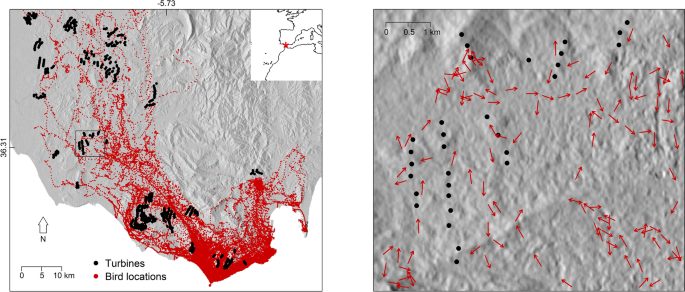2022-04-20 マックス・プランク研究所
・マックス・プランク動物行動研究所と英国イースト・アングリア大学の2つの動物追跡研究により、エネルギーインフラと衝突しやすい鳥類の飛行行動に関する詳細なGPSデータが提供されました。
・1つ目は、27種1,454羽の鳥を対象とした大規模な研究で、ヨーロッパで風力タービンや送電線から鳥が特に危険にさらされているホットスポットを特定しました。
・2つ目は、風車付近を飛ぶ鳥の行動に着目したもので、1km以内に風車があると、鳥は積極的に風車を避けることが明らかになりました。両研究は、高精度のGPS装置で鳥の動きを追跡することにより、野生生物への影響を最小限に抑えながら再生可能エネルギーのインフラを拡張するために必要な詳細な生物学的データを提供します。
<関連情報>
- https://www.mpg.de/18544955/0420-ornr-flying-into-a-clean-and-safe-future-987453-x?c=2249
- https://www.nature.com/articles/s41598-022-10295-9
飛翔する渡り鳥の風車回避行動に影響を与える要因の解明 Factors influencing wind turbine avoidance behaviour of a migrating soaring bird
Carlos D. Santos,Hariprasath Ramesh,Rafael Ferraz,Aldina M. A. Franco &Martin Wikelski
Scientific Reports Published: 19 April 2022
DOI:https://doi.org/10.1038/s41598-022-10295-9

Abstract
Wind energy production has expanded as an alternative to carbon emitting fossil fuels, but is causing impacts on wildlife that need to be addressed. Soaring birds show concerning rates of collision with turbine rotor blades and losses of critical habitat. However, how these birds interact with wind turbines is poorly understood. We analyzed high-frequency GPS tracking data of 126 black kites (Milvus migrans) moving near wind turbines to identify behavioural mechanisms of turbine avoidance and their interaction with environmental variables. Birds flying within 1000 m from turbines and below the height of rotor blades were less likely to be oriented towards turbines than expected by chance, this pattern being more striking at distances less than 750 m. Within the range of 750 m, birds showed stronger avoidance when pushed by the wind in the direction of the turbines. Birds flying above the turbines did not change flight directions with turbine proximity. Sex and age of birds, uplift conditions and turbine height, showed no effect on flight directions although these factors have been pointed as important drivers of turbine collision by soaring birds. Our findings suggest that migrating black kites recognize the presence of wind turbines and behave in a way to avoid then. This may explain why this species presents lower collision rates with wind turbines than other soaring birds. Future studies should clarify if turbine avoidance behaviour is common to other soaring birds, particularly those that are facing high fatality rates due to collision.


